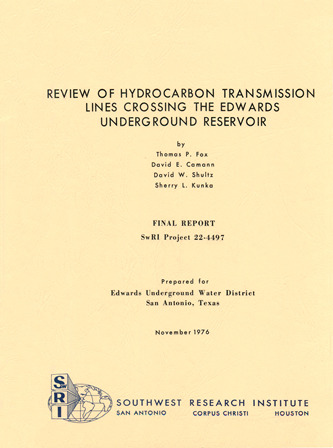Review of Hydrocarbon Transmission Lines Crossing the Edwards Underground Reservoir

| Summary |
|
Although little information has been reported on contamination of groundwater from crude oil trunk pipelines, the significance of these pipelines cannot be minimized. Hydrocarbon transmission lines are of primary importance in the consideration of contamination potential. Four of these main trunk lines cross the Edwards Underground Reservoir (EUR) for a total length of 237 miles. These lines cross drainage basins which provide an estimated annual recharge of 20 percent to the total Edwards Aquifer. Limestone aquifers such as the Edwards afford little or no filtration capability to protect groundwater from hydrocarbon transmission line leaks or spills. After surveying past experience associated with pipeline leaks, it was decided that the U.S. experience was an inadequate data base for predictive analysis; a review of Texas pipeline-related data provided a more adequate source of comparison. There have been nine reported leaks in the EUR from 1970 to the present (September 1976) with corrosion being the primary cause of such leaks. The total reported leaks in Texas from 1973 to 1975 were 1320; of these, 1008 were the result of crude oil pipeline corrosion. Pipelines crossing the EUR have experienced a significantly lower rate of leaks than pipelines over the rest of Texas. The EUR rate is less than 12 percent of the total Texas rate, and too few EUR leaks have occurred to indicate differences in causal factors of these failures. The 1975 Texas failure rate was determined to be 49.79 leaks/ 1000 miles/year while the EUR rate was determined to be 6.33 leaks/ 1000 miles/year. (A lognormal distribution provided the best model for the gross loss spill volume obtained from the total Texas data.) Further study and assessment produced these additional conclusions concerning future hydrocarbon transmission line leaks: ( l) Using the pessimistic Texas rate assumption, there is a near certainty of at least one oil leak over the EUR each year. By using the EUR rate, there is a 77-percent chance of one or more leaks occurring in a year; thus, it is likely that one or more leaks will continue to occur over the EUR in most years. (2) For both the U.S. and Texas crude oil pipeline leak experience, there is a trend of decreasing accidents in recent years. (3) Using the Texas rate assumption, the largest leak over the EUR is likely (about a 61-percent probability) to be between 100 and 499 barrels for a 1-year period. Using the EUR rate, the largest spill is expected to be less than 100 barrels (69-percent probability) for the same time period. ( 4) Using the Texas rate assumption, there is a high probability of the cumulative spill volume exceeding 1000 barrels for a time period of several years. The EUR rate indicates that the possibility of such a large spill volume is not too great for time periods of less than I 0 years. (5) Assuming that the EUR leak rate remains at its recent level (not considering the apparent trend in decreasing leak numbers), a sizable volume (2501to 6500 barrels) of crude oil is likely to be spilled over the EUR over a 20-year period. ( 6) The probability of a single leak greater than 10,000 barrels is negligible (0.1 percent) even for a 20-year time period using the EUR failure rate. (7) The predicted impact of small leaks (0 to 100 barrels) in nonstream and intermittent stream areas on the aquifer would be minimal. (8) The effect of a small leak entering a stream would likely be to cause oil to enter the aquifer. (9) The predicted impact of a large leak in nonstream areas of the aquifer is minimal because of the physical distance from the streams. (10) The predicted impact of a large leak on an intermittent or flowing stream on the aquifer is likely to be severe. As of this date, the Texas Water Quality Board (TWQB) has not established specifications for the construction of new pipelines crossing the Edwards Aquifer recharge zone. The four companies presently operating the pipelines crossing the EUR function under Federal Department of Transportation rules and regulations applicable to interstate transmission lines. Furthermore, based on the data generated by this study, the need for pipeline retrofit modification on existing pipelines does not appear to be justified at this time . |
Search for Documents
Advance Search
Explore EAA's Scientific Reports
- All Reports
- Remote Sensing
- Precipitation
- Overview Studies
- Modeling
- Hydrology and Hydrogeology
- History
- Groundwater Recharge, Recharge Zone
- Groundwater Movement
- Geomorphology and Caves
- Weather Modification
- Geology
- Water Use and Conservation
- Geochemistry
- Water Resources Planning and Management
- Floods and Drought
- Water Quality
- Climatology
- Surface Water / Groundwater Relationship
- Biology
- Springs, Groundwater Discharge
- Archaeology
- RZ Protection
- Aquifer Levels
